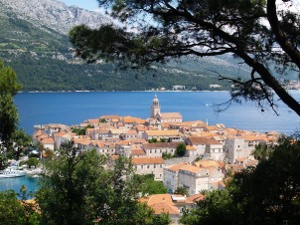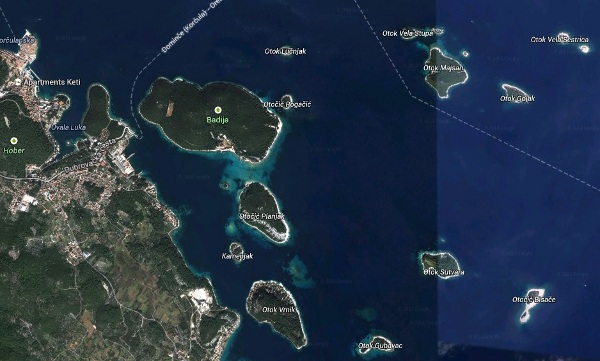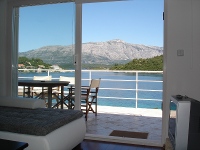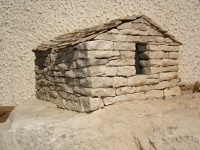 The town of Korcula is the tourist, economic and cultural center of the island of the same name. It is one of the best-preserved medieval cities in the Mediterranean. The town is full of beautiful narrow streets, fortresses and castles, churches and town squares. For a long time in history Korcula was under Venetian Republic. Venetian dodges fortified the town in order to ensure passage through Peljesac channel for its war and trade ships.
The town of Korcula is the tourist, economic and cultural center of the island of the same name. It is one of the best-preserved medieval cities in the Mediterranean. The town is full of beautiful narrow streets, fortresses and castles, churches and town squares. For a long time in history Korcula was under Venetian Republic. Venetian dodges fortified the town in order to ensure passage through Peljesac channel for its war and trade ships.
Korcula was built on a hill and fortified with stone walls. The entrance to the old city center is through the gate in Revelin Tower built in 1863. Streets of the town are distributed in the form of the fish-bone. The main street as the back-bone goes from the main Revelin Tower till the Zakrjan Tower on the north. Narrow side streets meet the main street under the angle of 90 degrees and in that way make fish bone. On the main city tower, Revelin, are two symbols of the Korcula history: the stone slab with a winged lion, the symbol of Venetian rule and the slab memorizing the coronation of the first Croatian King Tomislav int he 10th century.
The main Korcula's street leads towards cathedral Of St Mark from the 15th century. It has characteristics of the Appulian medieval art and Venetian-Dalmatian Gothic style. This stone beauty was built with the stone from the islands Vrnika and Kamenjak. Contructors were mostly local masters. The high altar is adorned with the altar painting by Jacopo Tintoretti. It represents three saints: St. Mark - protector of Korcula, St. Jerome - protector of Dalmatia and St. Bartholomew - protector of shipbuilders. The crypt of the altar keeps the sarcophagus with the bones of the other protector of Korcula - St. Theodore. In the 16th century the chappel of St. Rocco was added next to the cathedral and so it assumed its presenr appearance. Next to the cathedral was bishop's court - today mostly transformed the Abbatial Treasury. It was founded in 1954 by Ivo Matijaca and contains exceptional collection of works of art. In the neghbourhood is also the Town musem situated in beautiful palace Gabriellis from the 16th century. On the north side of the cathedral is church of St. Peter, from the 14th century, the oldest church in the town. In front of the cathedral is recenty reconstructed palace of Korcula nobel family Arneri.
In the old part of town Korcula is the house of Marco Polo. Next to the Zakrjan Tower is courtyard of Kanavelic family. There is the birth house of the great Korcula poet Petar Kanavelic. Primary school in Korcula town has his name. In the same street is Sea Gate Tower. On the tower is inscription to the glory of the Troyan hero Antenor who, according to the legend, founded Korcula. Near the west port of the town is a Loggia from 1548, an open area on stone columns. Today, there is the Tourist Board of Korcula. In the neighbourhood are big and small Prince's towers. On the east side of the town are Rampada with guns and Arsenal from 1572. Between Arsenal and the Town gates is tower Revelin.
The main square of the new part of the city is Plokata. There is a memorial font as a reminder of the arrival of water to the town of Korcula from the Neretva river, on 13. 06. 1986. Nearby is the St. Justina square with church that carries the same name. On the dome of the church is the statue of the resurrected Christ, the work of the sculptor Radica.
Street of St. Nicholas leads to the Dominican Convent (1905. g.). Further on are the church of St. Nicholas, promontory of St. Nicholas and Maksimilijan Vanka Gallery.
On of the symbols of Korcula is Moreska. It is a romantic war dance with swords that spread originally from the Mediterranean countries in the 12th and 13th centuries. It is supposed that Moreska first came to Korcula from Spain in the 16th century across the South Italy and Dubrovnik. Later, through centuries, Moreska disappeared from the Mediterranean while it is still deeply rooted in Korcula, where its today's pattern of an attractive war dance with real swords is unique in the whole world. Moro, the Black King's son takes by force and imprisons the White King's fiancee ( Bula ). There is a fight between the two armies. The fight consists of 7 parts or strokes ("kolap"). In the end the White army wins and Bula and White King are again together.





 The town of Korcula is the tourist, economic and cultural center of the island of the same name. It is one of the best-preserved medieval cities in the Mediterranean. The town is full of beautiful narrow streets, fortresses and castles, churches and town squares. For a long time in history Korcula was under Venetian Republic. Venetian dodges fortified the town in order to ensure passage through Peljesac channel for its war and trade ships.
The town of Korcula is the tourist, economic and cultural center of the island of the same name. It is one of the best-preserved medieval cities in the Mediterranean. The town is full of beautiful narrow streets, fortresses and castles, churches and town squares. For a long time in history Korcula was under Venetian Republic. Venetian dodges fortified the town in order to ensure passage through Peljesac channel for its war and trade ships.

